This homemade Farmers Market Pizza recipe is packed with fresh veggies. It's gluten free and made with an herb ricotta cheese spread.
Pizza is a great vehicle to utilize fresh summer produce that you've grown in your garden or picked up at a local farmer's market. This Vegetable Pizza is literally bursting with fresh ingredients!

Summer is nearing an end and it's the perfect time to consume all of those veggies we've grown in our gardens over the past few months. Late summer is also prime time to hit the farmer's markets, because most of the vendors stalls are literally overflowing with produce.
It can be difficult to know what to do with all that vegetal bounty, because it tends to arrive all at once and expires quickly. We do our best to can and pickle vegetables, but there's only so many hours in a day.
One of my favorite ways to use up a bunch of produce all at once is to pile them onto a pizza crust. There is no wrong way to make a pizza and this recipe is no exception.
It's made with a ricotta feta cheese spread and your favorite toppings of choice. The ricotta spread creates a canvas on the crust and can be topped any way you like.
Jump to:
- What Are The Best Vegetables To Put On Pizza?
- Do You Need To Cook Vegetables Before Putting On Pizza?
- How To Prepare Vegetables For Pizza
- Ingredients For Farmers Market Pizza
- How To Make Pizza Crust
- What Can You Put On Pizza Instead Of Tomato Sauce?
- How To Make Farmers Market Pizza
- What Else Can I Use To Top Vegetable Pizza?
- What Temperature Does Pizza Bake In The Oven?
- What To Serve With Vegetable Pizza
- How Long Does Pizza Last In The Fridge?
- Can It Be Frozen?
- Farmers Market Pizza

What Are The Best Vegetables To Put On Pizza?
When it comes to vegetables, there is no wrong way to top a pizza.
The one general rule I suggest is to choose vegetables with a similar cooking time and to cut or chop the veggies in a similar size to ensure that they cook evenly.
For example, zucchini and carrots have different cooking times. Zucchini cooks much more quickly than carrots, so I would not recommending using these two vegetables on the same pizza crust.
Sliced zucchini and eggplant, however, have similar cooking times and will cook evenly if added to the same pizza.
This Farmers Market Pizza is meant to utilize any vegetables that you may have grown in your garden or received in a CSA box over the summer. It's designed so that those fresh flavors are allowed to come through.
Here are some summer veggies that may be used to make this pizza:
- Eggplant
- Zucchini
- Summer Squash
- Bell Peppers (any color)
- Tomatoes or Roasted Tomatoes
- Onions
- Shallots
- Leeks
- Kale, Swiss Chard, Spinach, Arugula, or greens of choice
- Fennel
- Mushrooms
Do You Need To Cook Vegetables Before Putting On Pizza?
In general, it is not necessary to cook vegetables before adding them to pizza. If using a hearty vegetable with longer cooking times, it's best to roast that vegetable first.
Examples of vegetables that should be roasted before adding to pizza include beets, Brussels sprouts, kohlrabi, carrots, turnips, and broccoli.
Roasting these heartier vegetables will help to soften them and bring out their natural sweetness.

How To Prepare Vegetables For Pizza
It's simple to prepare vegetables for pizza. The key is to make sure that the veggies are relatively even in size, so that they cook evenly.
I find that it's best to slice vegetables like zucchini, summer squash, eggplant, and tomatoes into rounds.
Onions, shallots, leeks, or fennel may be diced or cut into thin strips, depending on your preference.
I like to dice bell peppers and slice mushrooms. Greens like spinach, Swiss chard, or kale may be roughly chopped.
Make sure to thoroughly wash any fresh produce to remove excess dirt.
Ingredients For Farmers Market Pizza
Here's what you'll need to make it.
- 2 Pizza Crusts (Gluten Free or Regular Crusts)
- 1 ½ cups Ricotta Cheese
- 1 cup (4 oz.) Feta Cheese Crumbles
- 1 tsp. Garlic Powder
- ½ tsp. Kosher Salt and Pepper
- 1 Tbsp. Fresh Thyme and Rosemary (or 2 tsp. Italian Seasoning)
- Lemon Zest
- Fresh Basil
- Balsamic Glaze (optional)
- Fresh Vegetables and Toppings of choice
I topped this pizza with a leek, fairy tale eggplant, summer squash, bell pepper, and Roma tomatoes, because this is what I had on hand. You can use these toppings, or customize it veggies of choice.
Roasted tomatoes are a great ingredient to add to a pizza like this one. Roasting the tomatoes brings out their natural sweetness and this makes for an excellent pizza topping.

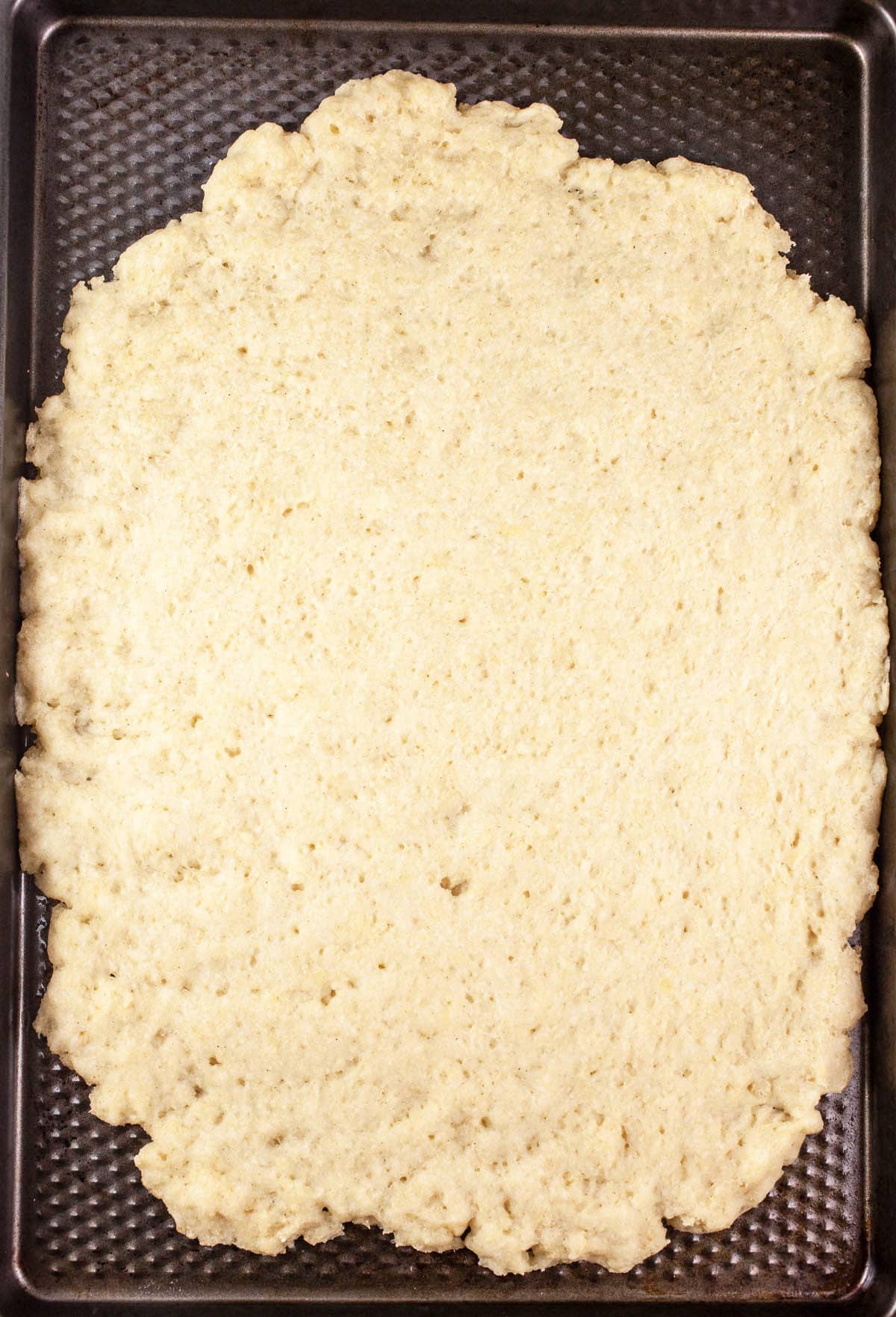
How To Make Pizza Crust
This recipe is gluten free and uses a gluten free pizza crust, but can be made using a regular crust as well.
The process of making gluten free pizza crust differs slightly, so it's important to keep that in mind. Gluten free pizza must be parbaked before adding the toppings. This is true whether the gluten free crust is made from scratch or a prepackaged mix.
I do not have a tried and true gluten free pizza crust recipe, so I opted for prepackaged pizza crust from Bob's Red Mill.
If making the pizza dough from scratch, check out this recipe for Gluten Free Pizza Crust and if making it with regular AP flour, check out this recipe for Homemade Pizza Dough.
You can also use packaged gluten free or regular pizza dough. Simply follow the instructions on the package if you go that route.
If making pizza dough from scratch, it's important to remember that it needs time to rise. Feel free to start the dough ahead of time and plan accordingly, whether making gluten free or regular pizza dough.
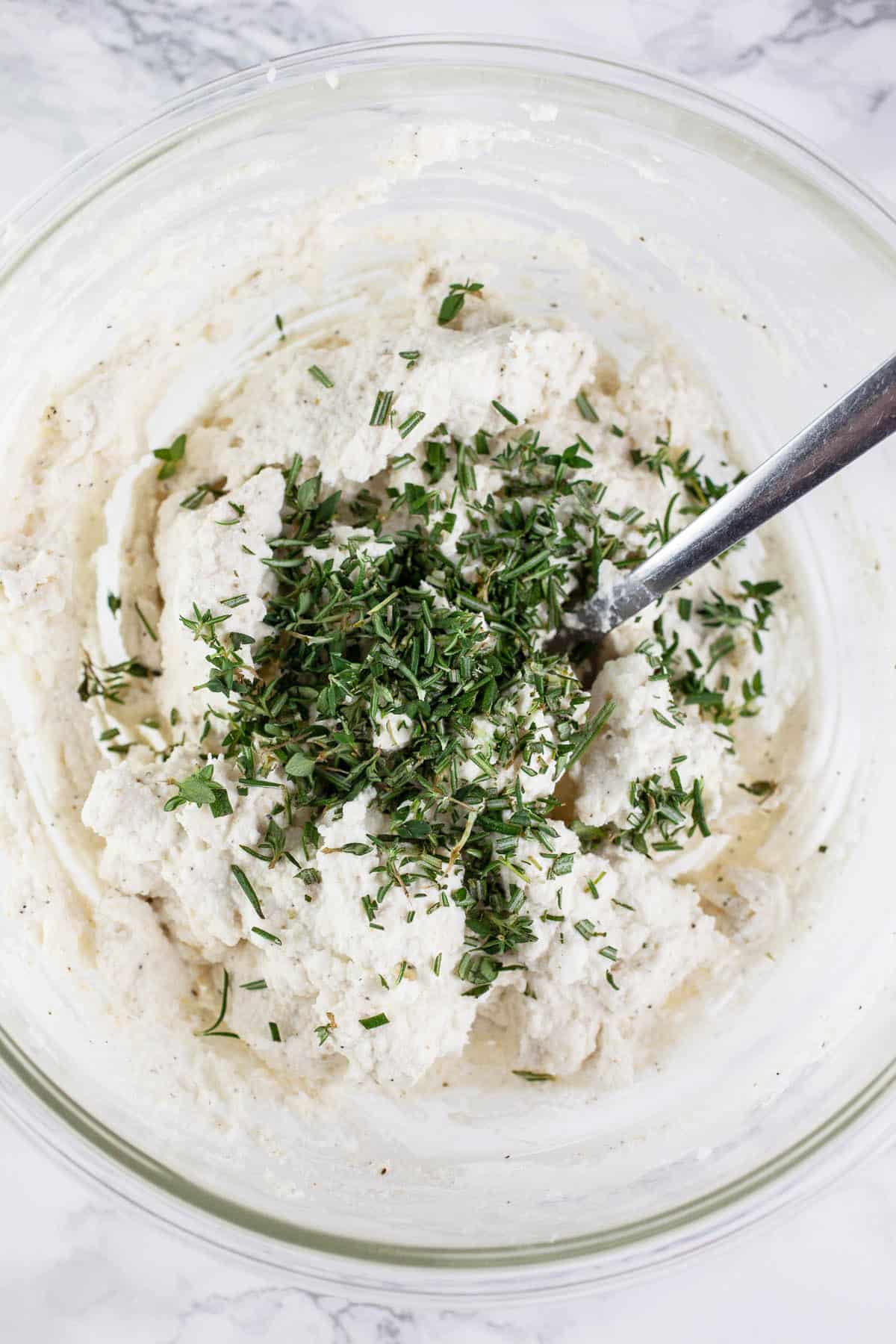
What Can You Put On Pizza Instead Of Tomato Sauce?
I love tomato sauce on pizza, but find that sometimes it overpowers the flavors of whatever is added on top of it. This is especially true when using delicate ingredients like zucchini and eggplant.
Tomato sauce is just one of many ways to top a pizza. It can also be topped using pesto, tapenade, béchamel, BBQ sauce, or herb butter.
This pizza is topped with a spread made from a combination of ricotta and feta cheese, garlic powder, salt, pepper, and Italian herbs. It provides the pizza with a base of flavor and allows the fresh vegetables to shine.
- To make the ricotta spread, start by mincing 1 Tbsp. each of fresh thyme and rosemary (or fresh herbs of choice). Oregano, dill, and tarragon are all great choices.
- Add 1 ½ cups full-fat ricotta, 1 cup (4 oz.) feta cheese crumbles, 1 tsp. garlic powder, ½ tsp. each kosher salt and pepper, and 1 Tbsp. each minced thyme and rosemary to a small bowl.
- Mix all of these ingredients together until completely combined.
If you do not have fresh herbs on hand, feel free to sub 2 tsp. Italian seasoning.
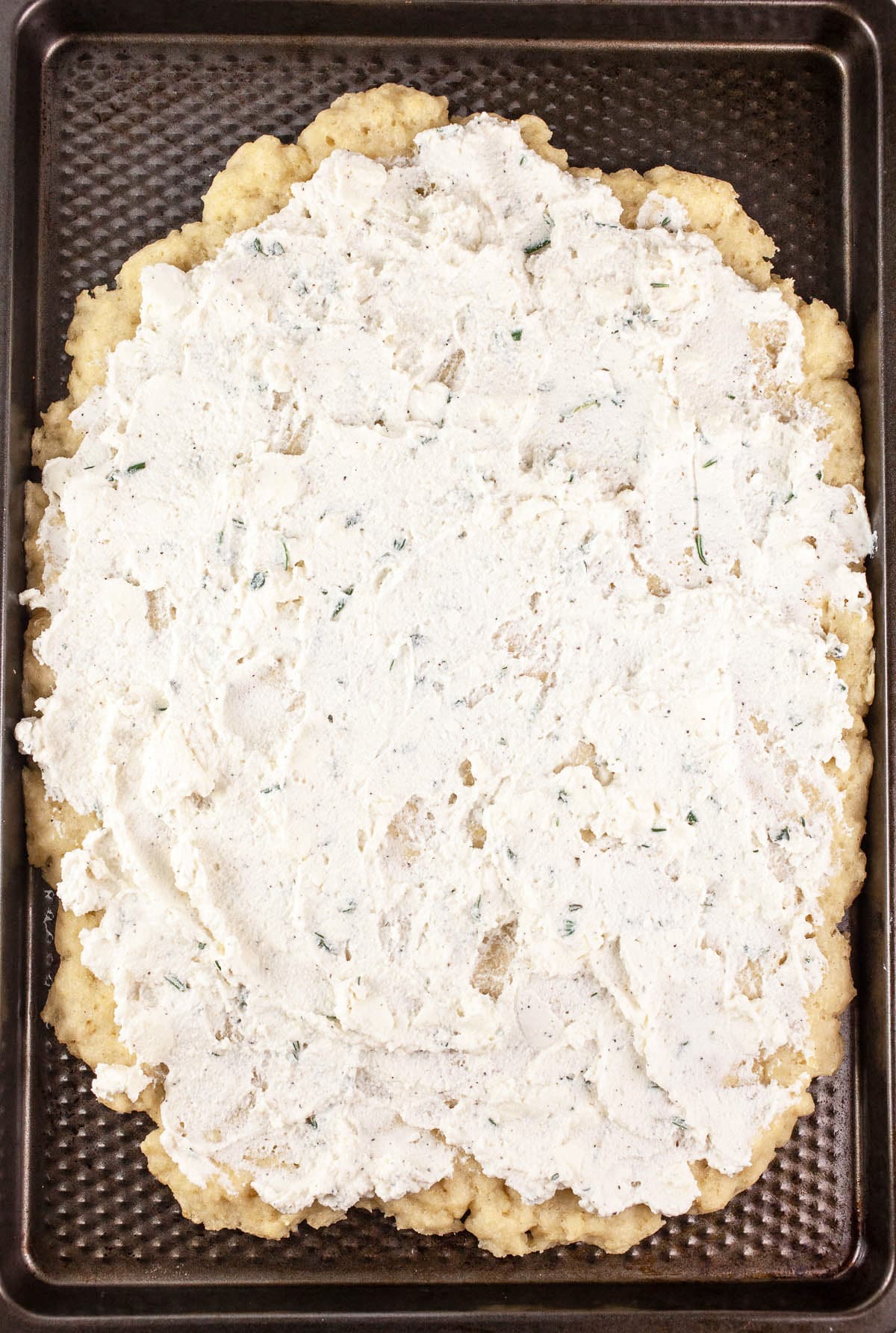

How To Make Farmers Market Pizza
The steps involved in making this pizza include preparing the dough and par baking it if the dough is gluten free, making the ricotta herb spread, chopping the vegetables, and assembling the pizzas.
After assembly, the pizzas are baked in the oven on baking sheets and finished with some fresh basil and lemon zest.
- Prepare the pizza dough according to recipe or package instructions and par bake the dough if necessary, making sure that you end up with two pizza crusts.
- Chop or slice any vegetables that will be used to top the pizza, making sure that the veggies are relatively the same size to ensure even cooking.
- Chop or prepare any other toppings that might be added to the pizza, such as olives, artichokes, or prosciutto.
- Prepare the ricotta herb cheese mixture.
- Once the crusts are par baked, evenly spread a generous amount of the cheese mixture onto each crust.
- Arrange the sliced or chopped veggies on top of the cheese.
- Add any extra toppings, such as olives, roasted red peppers, or artichokes.
What Else Can I Use To Top Vegetable Pizza?
This pizza can be topped according to your tastes.
I love to add something salty or briny to pizza, such as olives, capers, roasted red peppers, or marinated artichokes.
If not vegetarian, you can add pepperoni or cooked Italian sausage. You can also add some sliced prosciutto to the pizza after it has cooked.
Other topping ideas include caramelized onions, pickled veggies, or sundried tomatoes.
Feel free to add some extra cheese if you like. Mozzarella is a classic melty cheese. It's important to remember that ricotta cheese does not melt, so this pizza won't give you that quintessential cheese pull.
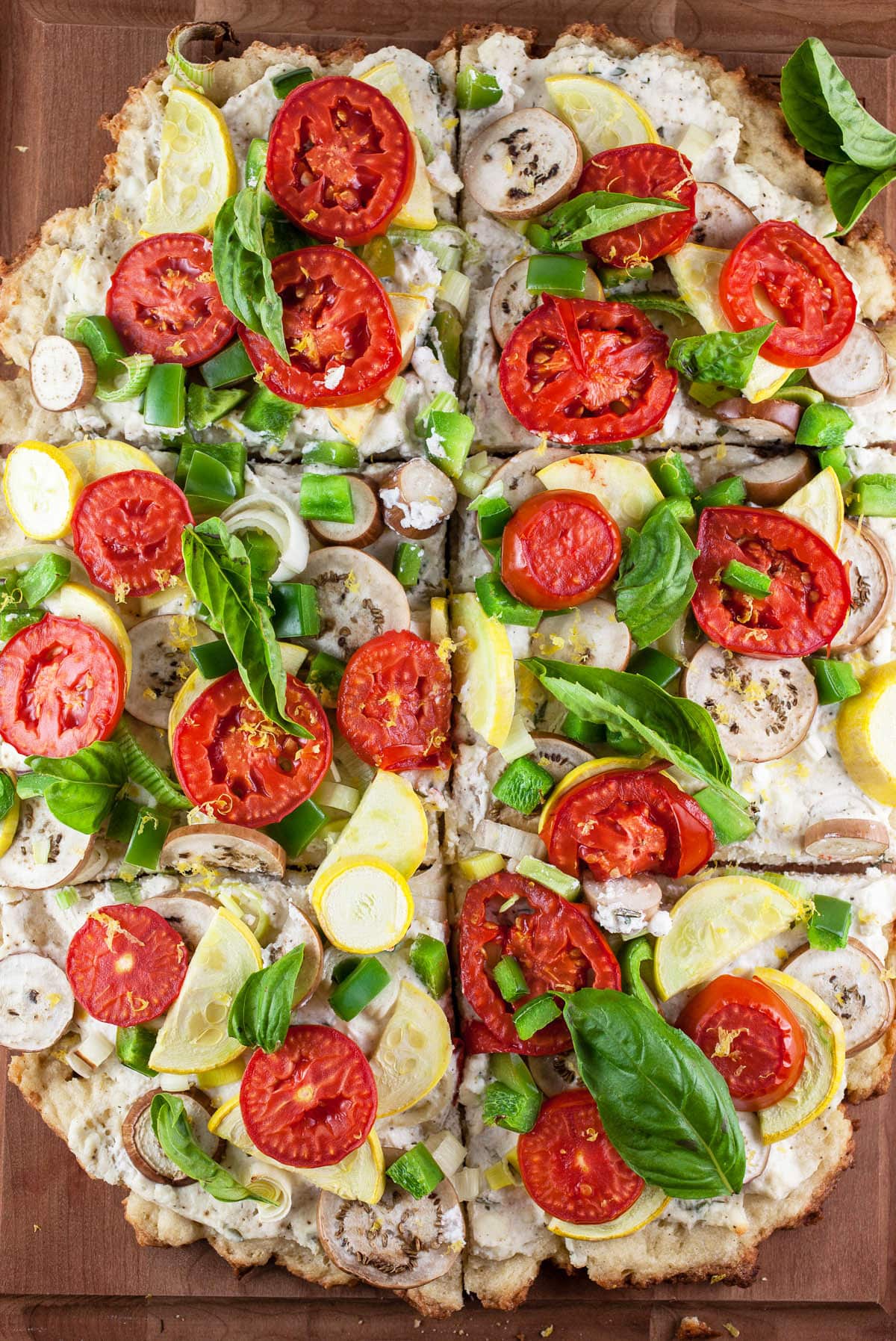
What Temperature Does Pizza Bake In The Oven?
It's important to bake pizza at a high temperature, so that the crust gets crispy and the toppings cook through.
The vegetables will soften, but not become mushy when baked.
- Heat oven to 425 degrees Fahrenheit.
- Place the baking sheets in the oven and cook for 12-15 minutes.
- Remove the baking sheets after the pizzas have cooked through, and cut them into slices.
It's important to remember that cooking times will vary slightly, depending on the type of crust used. The Bob's Red Mill Gluten Free Pizza Crust is par baked for 7-8 minutes and the assembled pizzas are baked for an additional 15-16 minutes.
The pizzas are done when the crust is golden brown and the toppings have softened slightly. It's important to remember that the cheese mixture does not melt in the oven.

What To Serve With Vegetable Pizza
If you want to brighten the flavors up and make them pop even more, add the zest of a lemon and some balsamic glaze over the top of the pizzas.
Balsamic glaze may be purchased in the grocery store or made at home. Make sure the brand used is gluten free if gluten is an issue for you. Check out this recipe if you'd like to use homemade balsamic glaze.
- Once the pizzas are ready, use a Microplane or small grater to zest a lemon over the top of them.
- Tear some fresh basil and spread it over the top of the pizzas.
- Drizzle some balsamic glaze over the top for a tangy kick (optional).
I love to serve fresh and flavorful dishes like this with a healthy salad like marinated tomato salad, Italian green bean salad, healthy pea mint salad, or pickled beet salad.

How Long Does Pizza Last In The Fridge?
Any leftovers may be stored in an airtight container for 2-3 days in the refrigerator.
Can It Be Frozen?
This vegetable pizza is best enjoyed fresh or within a few days and I do not recommend freezing it.
Love pizza? Check out these recipes!
- Arugula Pesto Prosciutto Pizza
- Mediterranean Veggie Naan Pizza
- BBQ Chicken Pizza
- Mushroom Arugula Pizza
- Sheet Pan Canadian Bacon Pizza
- Pizza Stuffed Peppers
- Chicken Pesto Flatbread
Looking for more vegetarian meals? Don't miss these recipes!
- Garden Vegetable Lasagna
- Roasted Vegetable Pasta Bake
- Lemon Pea Artichoke Risotto
- Baked Eggplant Parmesan
- One Pot Veggie Pasta
- Vegetarian Greek Stuffed Peppers
Looking For Farmers Market Side Dishes? Don't Miss These!
Italian Chopped Salad
Secret Side Salad
Greek Salad
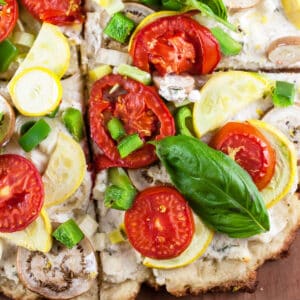
Farmers Market Pizza
Equipment
Ingredients
For The Crust:
- 1 package gluten free pizza crust such as Bob's Red Mill (equals 2 pizza crusts)
For The Ricotta Spread:
- 1 ½ cups ricotta cheese full fat
- 1 cup feta cheese crumbles
- 1 tsp. garlic powder
- ½ tsp. kosher salt
- ½ tsp. pepper
- 1 Tbsp. fresh thyme
- 1 Tbsp. fresh rosemary
For The Toppings:
- 4-5 fairy tale eggplants or Japanese eggplant or 1 small Italian eggplant
- 1-2 small summer squash or zucchini
- 1 leek or onion or shallots
- 1 bell pepper any color
- 3-4 roma tomatoes or roasted tomatoes
- 1 lemon zest only
- ½ cup fresh basil for garnish
- ¼ cup balsamic glaze optional
Instructions
For The Crust:
- Prepare 1 package of Bob's Red Mill Gluten Free Pizza Dough according to package instructions (or gluten free pizza dough brand of choice). Prepare 1 package of regular pizza dough if gluten is not as issue for you.Alternately, you can make homemade gluten free pizza dough or regular homemade pizza dough if you prefer.A few extra ingredients will be needed to make the crusts. The ingredients needed varies depending on the type of crust used.
- Make sure to allow enough time for dough to rise and par bake the gluten free pizza crusts for 7-8 minutes at 425 degrees Fahrenheit.
For The Toppings:
- Thoroughly wash and dry vegetables to remove any excess dirt.
- Dice the bell peppers, slice the zucchini or summer squash and eggplant into rounds, chop the leek, and slice the tomatoes, making sure that the vegetables are relatively even in size to prevent even cooking.Alternately, you can chop or dice any vegetables used to top this pizza. Veggie topping ideas include roasted tomatoes, mushrooms, onions, fennel, shallots, or greens such as kale, Swiss chard, or arugula.
- Chop or prepare any other toppings, such as olives, marinated artichokes, capers, or roasted red peppers.
For The Ricotta Spread:
- Mince 1 Tbsp. each of fresh thyme and rosemary (or fresh herbs of choice). Oregano, dill, and tarragon may be used.Alternately, you can sub 2 tsp. Italian seasoning for the fresh herbs if you prefer.
- Add 1 ½ cups full-fat ricotta, 1 cup (4 oz.) feta cheese crumbles, 1 tsp. garlic powder, ½ tsp. each kosher salt and pepper, and 1 Tbsp. each minced thyme and rosemary to a small bowl.
- Mix all of these ingredients together until completely combined.
Assemble The Pizzas:
- Once the crusts are par baked (if gluten free), evenly spread a generous amount of the cheese mixture onto each crust.
- Arrange the sliced, roasted, or chopped veggies on top of the cheese.
- Add any extra toppings, such as olives, roasted red peppers, or artichokes.
- Bake the pizzas for 12-15 minutes at 425 degrees Fahrenheit.Cooking times will vary, depending on the type of crust and amount of toppings used. The pizza is done when the crust is golden brown and the veggies softened, but not mushy.
- Remove the baking sheets from the oven and cut the pizzas into slices
- To Serve: Using a Microplane or small grater, zest a lemon over the pizzas. Add some fresh basil and drizzle with balsamic glaze (optional).


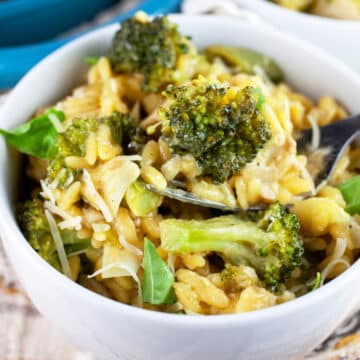
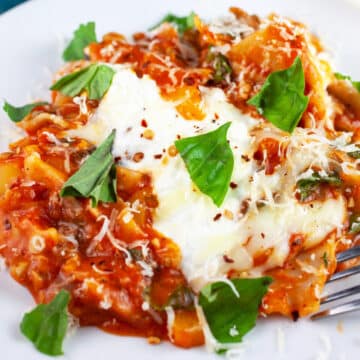


Leave a Reply